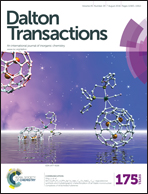Chemical consequences of pyrazole orientation in RuII complexes of unsymmetric quinoline–pyrazole ligands†
Abstract
A series of homoleptic RuII complexes including the tris-bidentate complexes of a new bidentate ligand 8-(1-pyrazol)-quinoline (Q1Pz) and bidentate 8-(3-pyrazol)-quinoline (Q3PzH), as well as the bis-tridentate complex of bis(quinolinyl)-1,3-pyrazole (DQPz) was studied. Together these complexes explore the orientation of the pyrazole relative to the quinoline. By examining the complexes structurally, photophysically, photochemically, electrochemically, and computationally by DFT and TD-DFT, it is shown that the pyrazole orientation has a significant influence on key properties. In particular, its orientation has noticeable effects on oxidation and reduction potentials, photostability and proton sensitivity, indicating that [Ru(Q3PzH)3]2+ is a particularly good local environment acidity-probe candidate.


 Please wait while we load your content...
Please wait while we load your content...